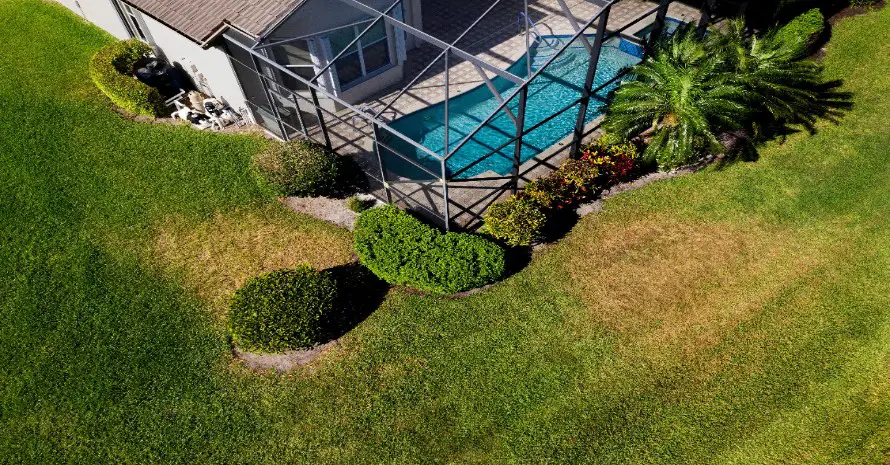A smooth green lawn with succulent St. Augustine grass is a decoration for any home. But what if you find bald areas, brown, yellow, or white spots on it? Then it’s time to choose the best fungicide for St Augustine grass. Even if you take proper care of your lawn, there is a chance of contracting fungal diseases. Some are not serious and appear as temporary patina; others can destroy plants in the affected area. In this article, you will find reviews on four great products to help you get rid of lawn diseases and prevent them from reoccurring.
Affiliate links and images placed from the Amazon Product Advertising API on 2024-07-27
4 Best Fungicides for St Augustine Grass
Among the most common fungal infections are brown patch, take-all root rot, gray leaf spot, and downy mildew. St Augustine grass disease identification is not difficult: you will definitely notice that your lawn has changed its color in some places. It is crucial to start using fungicides right away to prevent spreading.
1. My Top Pick: Dow AgroSciences Eagle 20EW
Affiliate links and images placed from the Amazon Product Advertising API on 2024-07-27
First on my list is a liquid St Augustine fungicide Dow AgroSciences Eagle 20EW. I like it because it is truly versatile. The treatment fights 15 different diseases, and at the same time, it can be used not only for lawns and ornamental plants but even for orchards. It comes in a 16 ounces plastic container and is a concentrate to be diluted in water. The ratio depends on a specific disease and the infected area.
The developer gas used Myclobutanil as an active ingredient here. It inhibits the synthesis of ergosterol in fungi, preventing its development. Although it has low toxicity to humans and pets, it is recommended that you take extra care while applying it. It can also be used with other lawn care products (including insecticides) due to its low cross-resistance.
- Effective against many diseases;
- Universal use;
- Compatible with other treatments.
- You need to dilute it in water.
2. Runner-Up: Scotts DiseaseEx
Affiliate links and images placed from the Amazon Product Advertising API on 2024-07-26
Scotts DiseaseEx is another product that is effective against fungus in St Augustine grass. It begins to provide a therapeutic effect within a day after application and retains its protective properties for a month. It has a form of granules and is packed in a bag weighing 10 pounds. This volume is designed for medium-sized yards (about 5000 square feet).
The active ingredient in this treatment is Azoxystrobin (belongs to the Strobilurins class). It has the widest range of effects and uses in agriculture compared to other popular fungicides. It is most effective at the beginning of an infection process, inhibiting disease-causing cells’ development and spread. However, fungi can adapt to its action, so it is not recommended to carry out too frequent applications (not more than 1-3 times a season).
- Treats a wide range of diseases;
- Inexpensive;
- Large packaging volume.
- Too frequent use is not recommended.
3. Great Value: Spectracide Immunox
Affiliate links and images placed from the Amazon Product Advertising API on 2024-07-27
I like Spectracide Immunox because it not only treats St Augustine grass diseases but also kills insect pests. You will appreciate its ease of use: just screw a garden hose onto its nozzle and adjust the flow rate. The water will mix with the treatment automatically; the main thing is to water the entire area evenly. The package contains 6 bottles of 32 fluid ounces. One container is sufficient for an average of 2500 square feet of lawn.
Propiconazole is used as an active ingredient here. Its distinctive feature is that its effectiveness does not decrease after rain. Moreover, protective properties can be maintained for 5 weeks. Scientific studies show that products based on Propiconazole have a stimulating effect on plant growth. So I recommend using this remedy if you want to know how to revive St Augustine grass after infecting.
- Can’t be washed off by rain;
- Kills insect pests;
- Stimulates grass growth.
- Dangerous for beneficial insects (e.g., bees).
4. Best for Diseases Prevention: Scotts GrubEx1
Affiliate links and images placed from the Amazon Product Advertising API on 2024-07-26
Brown spots in St Augustine grass can appear not only due to fungus but also because of the activity of damaging pests. Scotts GrubEx1 is capable of handling them. The key to success is a timely application: treat your lawn in late spring, and you will protect it from insects for four months in advance. One 28.85-pounds package is enough to process 10000 square feet of a lawn.
The main ingredient in this product is Chlorantraniliprole. It has a paralytic effect on insects and kills them within 2-4 days. Although the maximum efficiency is observed precisely on eggs and larvae, it affects pests at any development stage. It is not washed off with water and stays active even after heavy rain.
- Kills lawn pests effectively;
- Large volume;
- Water-resistant.
- A spreader is required for the uniform application.
Fungicide for St Augustine Grass FAQ
In this section, you will find answers to some common questions about St Augustine grass fungus treatments.
What is the best fungicide for brown patch St Augustine grass?
In my opinion, it is Dow AgroSciences Eagle 20EW liquid concentrate. It blocks the development of fungal cells effectively, stops damage to your lawn, and is easy to use.
Does fungicide kill grass?
No, such treatments act exclusively on pathogenic bacteria without harming the grass. In fact, some fungicides, on the other hand, promote plant growth by improving the process of photosynthesis.
When is the earliest you can use fungicide on a new lawn?
I recommend applying fungicide in spring when the grass is just starting to turn green. Since the development of diseases is directly related to the ambient temperature, start using them when it warms up to 60°F (around April). As a preventive measure, treat your lawn in October as well.
Choose the Best St Augustine Grass Brown Patch Treatment
The most effective lawn disease treatments contain Myclobutanil, Azoxystrobin, Chlorantraniliprole, or Propiconazole. Certain types of fungi can develop a defense mechanism against a particular fungicide over time, so it is recommended to change them periodically. But I still consider Dow AgroSciences Eagle 20EW to be the best at managing St Augustine grass brown patch. You can choose other items from my list as a replacement option. Remember, the key to success is the timely identification of a specific disease.
Have you ever encountered a lawn disease? Which product was effective? Please share your personal lawn protection tips with other readers!








